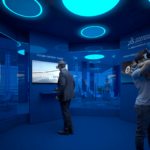From AI to live-streaming, new technologies are capable of adding ‘wow’ to live events – but it’s the human touch that creates a real sense of belonging .
Technological advances, if we’re honest, can easily seem as scary as they are welcome. For all those early-adopters and techno-utopians, new advances promise great and facilitating change, but they also come with plenty of unpredictability. As the great 20th century cultural commentator Marshall McLuhan said:
“It is the framework which changes with each new technology and not just the picture within the frame.”
AI and aerospace
Industries of every variety are speculating right now about the impact of both virtual reality and artificial intelligence, with the construction industry considering the reality of human-free construction sites within the next decade, for example. Closer to home, for the aerospace industry, what does the future hold? Leaving aside technology’s impact on engineering and mechanical processes, what might the impact be on the great annual investment in shows and events? Will physical presence at exhibitions have an enduring value in a world of virtually everything?
New technology being used in events and exhibitions should always be focused on enhancing interactions between humans, rather than replacing them
We would say first of all that new technology being used in events and exhibition should always be focused on enhancing interactions between humans, rather than replacing them. After all, building relationships is the number one reason delegates attend events. Taking an example from the world of fashion, superstar designer Tom Ford embraced the future by presenting his Spring-Summer 2016 show in an entirely virtual format, via a Nick Knight-directed video featuring Lady Gaga, but has since returned to the traditional catwalk. There are aspects of the real and the physical, it seems, that will always convince potential buyers at a deeper level, from shaking someone’s hand or looking them in the eye to being able to assess product quality under close inspection.
Everything we invent is an extension of some human faculty, from the everyday use of knives and forks that extend the existing capacity of our teeth and fingers to AI itself which, after all, is simply an extension of our own brain capacity. Marshall McLuhan also wrote: “A typewriter is a means of transcribing thought, not expressing it” and now is a good moment to underline that we are still the ones in charge and that technology, well-directed, can and should be at the service of human values above all.
‘Why’ as important as ‘wow’
Of course, exhibitions need to offer delegates an experience. We saw many brands at the Geneva Motor Show this year, for example, offering a great mix of opportunities for interactivity, from VR experiences to gamification. However, an experience doesn’t just mean showing whatever the R&D department is working on, especially if successful outcomes are a gamble. How about the LG robot Cloi repeatedly failing on stage at its unveil at CES 2018, for a moment to make us all shudder. The lesson surely is that there has to be a good enough answer to the ‘why’, when showing new technology, as well as a well-rehearsed Plan B, rather than just hoping the ‘wow’ will do the trick on its own.
Naturally, there are great examples of technological integration too. Whilst it took a while for AR and VR to move beyond being a fun gimmick to becoming a really useful tool in the event manager’s arsenal, we were certainly impressed recently by DB Pixelhouse’s virtual hangar and its relevance for the aerospace industry, where logistics and access issues can make it hard for visitors to get a true picture of large items such as planes.
Blend online and face-to-face interactions
Other industries are showing the way too. The retail industry, as ever, is a forerunner in terms of brand activity aimed at remaining relevant and getting people to interact. Pop-up ‘brand playgrounds’ like the Jack Daniels Lynchburg General Store’s pop-up in New York, for example, to celebrate the brand’s 150th birthday, included a pamper area with local barbers and stylists, an education zone to learn about the art of barrel-making, an eating area for sampling southern cooking, plus a VR tour of the distillery. The flexible pop-up general store concept can also be packed up and moved to the next town, just like a modular exhibition system.
The live event is often the catalyst to integrating the host company into the innovation process of their customer’s or the consumer’s life. To achieve this aspirational status, it’s critical to have inspiring live events that create a sense of belonging, combined with engaging online interactions actively moderated by a human ambassador, just as you would for virtual events, meetings and live-streaming. Live-streaming represents a fundamental cultural shift disrupting business and, by implication, the events world, covering a multitude of techniques for B2B sessions to be broadcast over Webex, YouTube or Facebook Live. These channels always work best when a human ambassador/real expert is delivering the broadcast and nurturing interactions, ensuring remote audiences remain engaged.
An event no longer exists in a single place or time and single experiences no longer fit all. As audiences demand to create the interaction they want, events are moving from mass consumption to mass customisation, meaning that innovation in events should mean more than new tech solutions.
Face-to-face – a premium commodity?
Could we also see a concurrent rise of premium events with no tech perhaps? An opportunity to spend valuable, focused time with stakeholders, given the power of face-to-face is such a valuable commodity?
There are many roads and exciting possibilities ahead, but it’s still up to us to create the signposts and be clear about where we want to go and what we want to achieve from our programmes of live events and exhibitions, as well as from the technology we use within them. Wouldn’t it be great if what the digital age really taught us is what we want and appreciate most from the real world?

